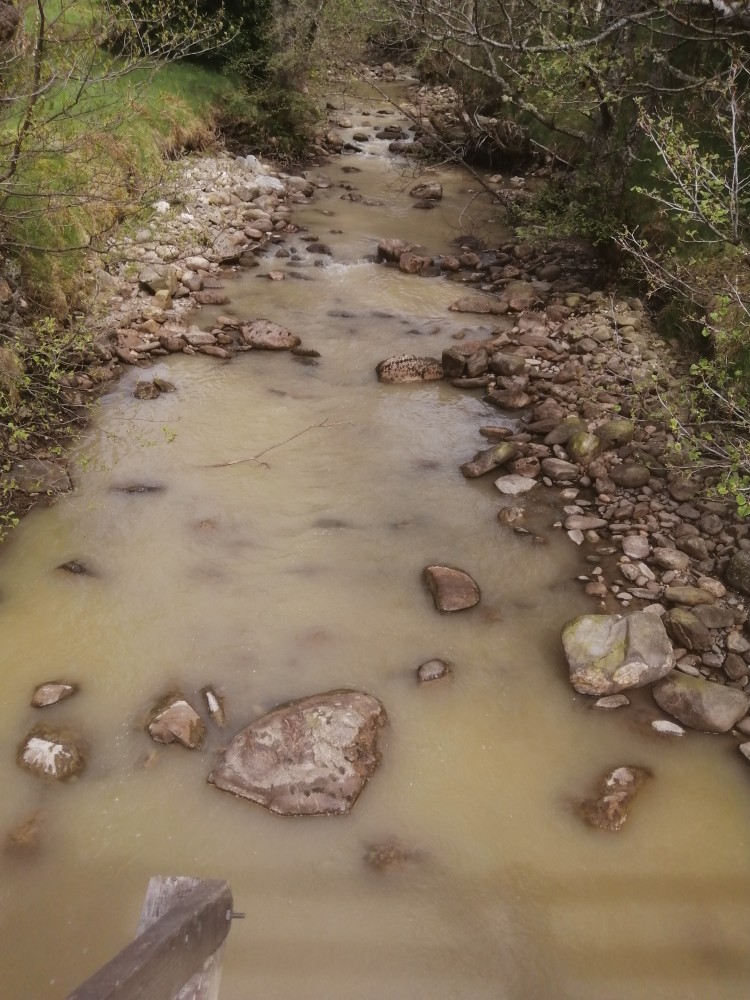
[This post has been updated to clarify the difference between the River Spey SAC and River Spey SSSI]
While not nearly as bad as it was (see here), the consequences of the engineering works in the Allt Mhor/River Gynack continue to flow down in the River Spey river system. Silt has now been washed down into the River Spey Special Area of Conservation (SAC), which is meant to be one of the most highly protected rivers in Scotland, for over eight days.
According to an email I have had from the Cairngorms National Park Authority (CNPA), the origins of the sediment lie in river works above the intake to the Kingussie floodwater alleviation channel, but whether they are connected to the repair (see here) of that channel is unclear. I have pointed out to the CNPA planning department that had revised plans been submitted by the Pitmain Estate for the repairs works they would have known whether these works were connected with the repairs or about something else.
The CNPA then visited the site on Thursday 18th, by which time sediment had been flowing into the Spey River system for a week. Had staff visited as soon as they became aware of the problem, they might have been able to issue a Stop Notice and reduce the damage.
I understand too from the CNPA that SEPA has been out to visit the site (thanks to at least one parkswatch reader who reported the problem to SEPA) and the works are within the scope of the CAR (Controlled Activities Regulations) it issued. If true that would make it harder for the CNPA to act but also raises wider questions about the fitness of the CAR regulations to protect designated river systems.
While the lower reaches of the River Gynack are in the River Spey SAC, they are not also designated as a Site of Special Scientific Interest (SSSI) unlike the River Spey itself. The River Spey SSSI, which was first designated in the 1980s, only covered the main river and was not extended to cover its tributaries when they were included in the SAC. This is potentially important because for each SSSI Scottish Nature Heritage/NatureScot issues a list of Operations Requiring Consent and can, under the Wildlife and Natural Environment (Scotland) Act 2011, issue Restoration Orders where a SSSI is damaged. No such powers exist in relation to SACs, a toothless designation although supposedly intended to protect Scotland’s most important sites for wildlife.
The potential protection afforded by SSSI status, however, is limited to the site itself and in the case of rivers, where pollution can originate upstream , this is particularly significant. It is questionable therefore how far NatureScot could take any action against Pitmain for damage to the River Spey SAC or SSSI though they could stop paying for river restoration, as they have done in Glen Banchor (see here), and peatbog restoration on the estate.
What has happened in the River Gynack should be enough for NatureScot, which is responsible for designated sites, to ask the Scottish Government to instigate a review of how Scotland’s SACs are protected. To show its serious, NatureScot should now also commission a report into the impact that the silt on wildlife, particularly the populations of Freshwater Pearl mussel that live in the Spey.
What has happened on the River Gynack raises serious questions about the ability and willingness of our Public Authorities to protect the natural environment, even where this is protected as a SAC and is a National Park – so much for the nature emergency. But it also raises serious questions about land-ownership and the fitness of the Jafur family to own the Pitmain Estate. Ultimately, they are responsible for what has happened Unfortunately, none of our Public Authorities and few of our politicians are prepared to say that landowners need to be held to account. Nor is acknowledged that people whose wealth is derived from activities that are changing the climate and damaging nature, such as oil, are unlikely to put conservation interests first. The implication, as evidenced by what has happened at Pitmain, is that until questions about the fitness of people to own land in National Parks are addressed, nature will continue to suffer.